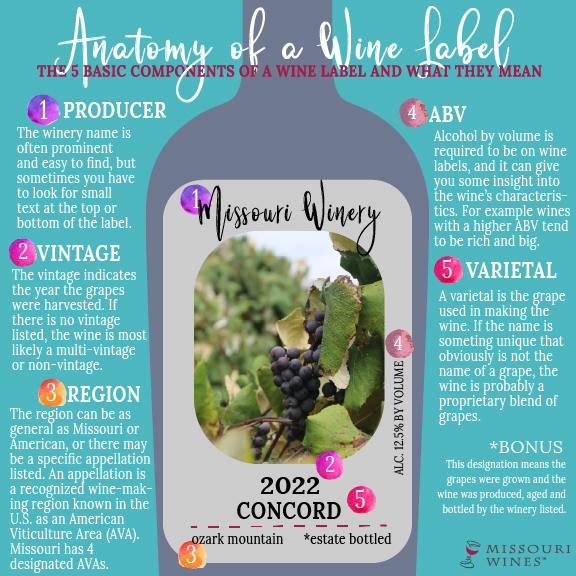As the saying goes, you should never judge a book by its cover, but wine is different. Whether adorned with traditional script writing and estate crests or splashed with bold colors and modern design, wine labels are created to tell potential customers the back story of that bottle. Every wine label has five basic components, which can help wine lovers learn more about that wine before ever opening the bottle. Let’s explore each component of a wine label and what you can learn about that wine with some light label reading.
Producer: The producer is simply who made the wine. In the case of Missouri wine, the winery’s name is often prominently displayed on the bottle. If the wine’s name takes center stage in the label design, search the smaller print for the producer.
Region: Each bottle of wine notes the region the grapes were produced. This region can be pretty general, such as “Missouri” or “American,” or the label may list a specific appellation or a legally-labeled specific region known for growing high-quality grapes. In the U.S., appellation regions are called American Viticultural Areas (AVA). Missouri is blessed with five AVAs — Augusta, Hermann, Ozark Mountain, Ozark Highlands and Loess Hills District.
Vintage: The vintage tells label readers the year the grapes were harvested. Since the grape harvest is the first step in the wine-making process, the vintage may differ from the year the wine is bottled and released. If no vintage is listed, that wine is either a multi-vintage or non-vintage.
ABV: ABV stands for alcohol by volume, and it must be printed on every wine label. Of course, the alcohol content can give you some clues about how slowly you should sip and savor your Missouri wine, but it can also provide context into the wine’s characteristics. Generally speaking, the higher the ABV, the bigger and richer the wine will taste.
Varietal: The varietal, or type of grape, which the wine is made of is typically printed on the label. Missouri is home to several unique varietals with their own trademark tastes and characteristics. If a grape varietal isn’t printed prominently on the label, that wine is likely a blend of several types of grapes.
While these five basic label components are undoubtedly helpful, they aren’t the only clues you will find on each wine label. Look at the design, colors and font colors to get a “feel” for the wine and/or winery. Read the back label for that bottle’s backstory, more information about the winery, and even pairing and tasting notes. Other helpful notations can also provide more context on that bottle of wine. One often seen in Missouri is “estate bottled,” which means the grapes were grown, and the wine was produced, aged and bottled by that winery.
Take the time to read wine labels and tell us what you learned by tagging us on social media at #MOwine. Then, put your new skills to use with the upcoming People’s Choice portion of the wine label contest.
